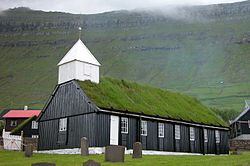Church of the Faroe Islands
| Church of the Faroe Islands | |
|---|---|

The old wooden church of Gøta.
|
|
| Classification | Protestant |
| Orientation | Lutheranism |
| Polity | Episcopal |
| Bishop | Jógvan Fríðriksson |
| Provost | Uni Næs |
| Region | Faroe Islands |
| Origin | Ólavsøka 29 July 2007 |
| Branched from | Church of Denmark |
| Members | 39,735 |
| Official website | www |
The Church of the Faroe Islands (Faroese: Fólkakirkjan) is one of the smallest of the world's state churches. Prior to its becoming independent on 29 July 2007, it had been a diocese of the Church of Denmark, a Lutheran church. About 81.6% of the Faroe Islanders belong to the state church.
Other churches in the Faroe Islands include the Plymouth Brethren and the Catholic Church.
According to Færeyinga saga, it was the Viking chief Sigmundur Brestisson who brought Christianity to the Faroe Islands. On the orders of the Norwegian king Olaf Tryggvason, Sigmundur forced the island people to convert to Christianity in 999. Resistance to the new religion led by the notorious Tróndur í Gøtu was quickly suppressed, and even though Sigmundur himself lost his life, Christianity gained a foothold.
About one hundred years after the introduction of Christianity, the Faroese church joined the Roman Catholic church, with an episcopal residence in Kirkjubøur and subject to the archdiocese of Nidaros (Tróndheim) for most of the time. From the time Christianity was introduced until the Reformation there were probably 33 bishops in the Faroe Islands.
This period was not always peaceful. The sagas of the Faroe Islands contain two accounts of the way the church took possession of a large proportion of the land, overtaxing the people so harshly that it led to open rebellion. The saga of the battle of Mannafallsdal relates that the bishop (probably Bishop Erlend, appointed in 1269) was killed outside his church by the rebels. The historical value of this saga is highly debatable - but it does serve to illustrate the conflict between the theocratic church and an impoverished population. However, there is reasonable documentation of the fact that the bishop's residence in Kirkjubø was burnt to the ground by the rebels, and that Erlend was removed from the islands by order of the King. Bishop Erlend died in Bergen in 1308.
...
Wikipedia
